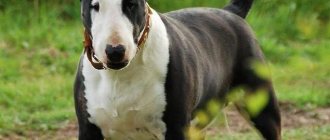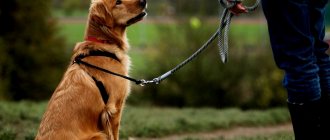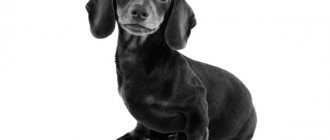This dog is smart and quick-witted. And if we are talking about a purebred dachshund, then training should begin from the first days of its appearance in your home.
It is based on conditioned reflexes that are formed in the dog through numerous repetitions of commands, actions and stimulation with treats. So, let's find out how to properly train a dachshund.
Teaching dachshund commands must necessarily be preceded by cultural and educational work. This is teaching the puppy its place and name, rules of behavior on the street and diet, leash and collar. It’s better not to delay training and start it from the first days the dog appears in your apartment or house. You will notice that the dachshund develops a behavioral stereotype very quickly. A dog that is smart by nature will understand where its place is and will respond to its name in 3-5 days. The dachshund also subtly senses the gentleness of its owner, and if he allows it, he will begin to beg at the dinner table. All such actions of an adult dachshund are the result of omissions in raising a puppy. Therefore, immediately teach him to use the toilet, do not whine or run around at night, do not chew things, do not beg at the table.
The dog is taught the name and place at the same time. Say the dachshund’s name several times and place it in the designated “registration” area. In this case, the “place” command, as well as all subsequent ones, must always be pronounced in a stern and clear voice. You see that the dachshund has completed it, stimulate it with a treat. Next, teach your pet the “fu” command. This prohibiting command will be useful to you at home, on a walk, or while hunting. The command should sound at those moments when the puppy makes unwanted actions. If the dog starts chewing furniture, then be sure to buy him toys, and as soon as you see such a dirty trick, immediately pull the dog back and strictly say “ugh.” But don't hit or yell at the dog. Don’t give your dachshund all the toys at once, because he constantly needs new impressions and simply cannot keep several objects in the center of his attention.
When your pet remembers its name and knows its place, put a collar on it. Let him walk around the house and get used to it. After several days with the collar in the house, try attaching a harness and leash and taking your dachshund for a walk in the yard. By the way, breeders do not recommend buying heavy leashes with a carabiner for this breed of dog. They will interfere with the movement of your small pet. There is no need to pull on the leash in the first days. But a few days after adaptation, it is advisable to accustom the dog to the “come to me” command. To do this, call the dog’s name, strictly pronounce the command and lightly pull the puppy towards you with a leash. It should be at your right foot, running parallel to you. Over time, your Dachshund should perform this command in distracting conditions outside, for example, the noise of cars, the barking of other dogs. The pet must obey all your commands in a noisy environment.
Since the dachshund belongs to the category of burrowing hunting dogs, in addition to general commands, it must also carry out working commands. Training in this direction is called baiting. And it begins with teaching the dog the ability to look for a treat. Take a piece of meat and let your dachshund smell it. Then place it away from the dog and give the command “search.” The dog senses the location of the meat by smell. Before this, your dachshund should already obey the “fu” command. Therefore, as soon as she approaches the meat, immediately say it. Next, you need to complicate the task and hide the meat further. Voice the “search” command, and after completing it, stimulate the dog with a treat.
When training a dachshund or baiting it, it is important to always pronounce the command the same way and clearly. That is, always order to “seek” and do not say “seek.” Command “come to me”, but do not say the phrase “come to me, I told you.” This way you will only confuse your pet.
Give commands strictly and clearly, and praise the dog kindly and gently. And don’t be upset if from the first days of training you don’t see unquestioning execution of commands. A dog, even the smartest one, is not a robot.
Raising a dachshund
Teaching commands should be preceded by educational work. These include:
- teaching a puppy a name,
- in place,
- to the feeding regimen,
- to the rules of behavior in the apartment and on the street,
- to the leash and collar.
If you can wait a few months with training, since there are known cases of successful training even for adult dogs, then it is better not to delay training. Dachshunds develop behavioral stereotypes very quickly. This is a smart dog, and she will quickly understand that life is much more interesting if the owner turns a blind eye to it.
For example, some dachshunds love to beg at the table, jumping on the person with their front paws and whining. All unwanted actions of an adult dog are the result of lapses in education. You need to start raising a dachshund by establishing contact and mutual understanding with it.
At first, the mother was the authority for the puppy, then the owner should take her place. The puppy must learn the rules of life next to a person:
- don't whine and don't run around at night,
- get used to using the toilet in a designated place,
- do not chew furniture and things,
- don't steal food from the table.
As soon as you bring your puppy home, determine his place. When he tries to climb onto a chair or asks to sit on your bed, take him to a rug or lounger and say: “Place!” Immediately begin to enter the prohibitive command “Ugh!” It should sound every time the dachshund puppy does an unwanted action. For example, he whines in front of your bed.
If the puppy is not given a place right away, he will choose it for himself and it will be very difficult to convince him otherwise. Create a daily routine for your dachshund and try to strictly follow it. This will help to quickly accustom the puppy to walking outside, and in general will have a positive effect on his discipline. Feed her only in a designated place at certain hours.
Be sure to buy toys for your dachshund, just don’t give him everything at once. The puppy constantly needs new experiences, but he is not able to keep many objects in the center of his attention. Once your dachshund has become a little more comfortable in its new home and has stopped acting restless in search of its mother and siblings, put a collar on it. Let her walk around the house in it to get used to it.
Then you can try wearing a light leash. Do not choose heavy leashes with a carabiner for your dachshund, which will interfere with its movement. At first, do not pull on the leash, allowing the puppy to run freely on it behind you or in front of you. But you should immediately stop it with the command “Ugh!” dachshund trying to play with the leash. She must understand that this is not a toy, but a means of controlling her movement.
Subsequently, this will help when teaching the “Walk!” command, when the dachshund will see the difference between calmly walking on a leash and running about its business. Reward your dachshund every time for good behavior.
Before 4 months of age, it is difficult to train a puppy to go to the toilet only outside. You can’t punish him for this, but you can just say “Ugh!” every time you see him going to do his chores at home. On the street, on the contrary, encourage him. So, gradually, the dachshund will become a clean dog.
Dachshund training
Training a dachshund is very interesting, given its small size and unusual constitution. For example, the command “Lie down!” does not significantly reduce the size of the dachshund and from afar you may not even be able to see whether the dachshund is standing or lying down. The technique of any training can be reduced to three actions:
- The dog is forced to make the desired movement in different ways.
- They make sure that performing the movement brings positive emotions to the dog, that is, they give a treat or praise and pet it.
- Before performing the movement, the required command is given.
All these actions need to be done 3-5 times in a row to strengthen the reflex. For successful training, it is important to interest the dog in following the command. It is difficult to give specific advice here; it all depends on the individuality of the dog. But most dachshunds love tasty morsels, so they train faster for treats. Training should go from simple to complex. Until the age of two months, simply train the puppy by entering the commands “Ugh!”, “Place!” and “Come to me!”
Then start learning the basic commands:
- "Sit!",
- "Lie!",
- "Near!",
- "Stand!",
- "Walk!".
From about three months onwards, training should be carried out in conditions of distractions on the street, when you can hear the noise of cars and other people talking. If you do not accustom your dachshund to the noise of city streets in time, it will then be afraid of it and lose the ability to respond to your commands in a noisy environment.
In principle, you can finish training your dachshund here, since the basic commands are enough for a harmonious life in human society. But if you want to expand the abilities of your dachshund, then teach it the “Stranger!” command, find things by smell, and carry out fetching objects. The hunting instincts of a dachshund, like a burrowing dog, can also be developed through special training called baiting.
At what stage to finish training a dachshund depends on the decision and interests of the dog owner.
If the owner is a creative person, then his dachshund skillfully performs various tricks: serves, dances, and brings various objects. A smart dachshund can be taught almost all the skills available to a dog's intelligence.
Did you like it? Share with your friends!
Give it a like! Write comments!
Stages of training
The psycho-emotional, mental and physical development of the dachshund is different at different stages of growing up. A small puppy will not be able to understand what is wanted from him if training begins before a certain age. From the first days the puppy appears in the house, you need to start accustoming the baby to:
- nickname;
- home toilet - a tray or a reusable diaper;
- place and mode of feeding;
- place to relax.
A puppy only develops reactions to bilateral contact between the ages of 3 weeks and 1.5 months. They begin to actively explore the territory, imitate, and master pack behavior. From 1.5 months a person can interact with a pet. The puppy already distinguishes between friends and strangers, learns to regulate its behavior depending on the behavior of people and animals, and distinguishes the properties of objects. He is already ready to accept prohibiting commands and positive encouragement with the help of affection and treats.
During the “Childhood” period, which for a dachshund lasts from 1.5 to 3 months, the baby is able to coordinate his movements, is active and mentally developed enough to begin learning commands. But he is not yet able to concentrate for a long time, so lessons should not exceed 5-10 minutes. The older the dachshund gets, the longer the training.
The training and upbringing of a child should be carried out taking into account his physiology. For example, during the period of growth and change of teeth, you should not forcefully pull objects out of your pet’s mouth. This can lead to the formation of an incorrect bite.
The elongated body of the dachshund causes weakness and instability of the spine. Babies should not jump from a height, they should not be lifted by the withers and paws, or sharply pulled by the harness or leash. Experienced dog trainers compare a dachshund puppy to a capricious little child and advise starting training very carefully.
Standard methods of mechanical impact are not applicable to the dachshund. Dachshunds don't try to figure out what they did wrong. The puppy will simply withdraw or become disobedient. During the “teenage” period, the dachshund can be stubborn and refuse to follow commands. This is how the dog determines the boundaries of what is permitted and identifies the “leader of the pack.” Only consistency, perseverance and patience will help you cope with teenage “rebellion”.
Let's start with simple commands
There is no need to think that if the puppy is small and defenseless, then he should definitely be pampered and allowed to bite.
On the contrary, this is the most suitable age for painless adaptation to the rules at home.
It won’t even occur to a young dog that he can live differently, without obeying commands.
And in the future he can set an example for his children or a new brother. Therefore, such simple requirements as: “ugh” and “place” can enter your vocabulary.
The prohibitive word “fu” can be used in such cases when: a dog barks or whines for no apparent reason, chews furniture or your shoes, begs for tidbits from the table, tries to bite someone, etc.
But it is worth remembering that any ban must contain an alternative. For example: if you want to stop your dog from chewing the wrong things, then he must have something that he can chew.
It may be an unnecessary slipper or a bone from the veins. And if he asks for food from the table, then he must have enough of his own dog food. Only then will the pet be able to easily learn commands.
The “place” command should sound if the dog: jumps onto elevated places in order to lie down or climb, asks to be held, pees on the floor, is located in different corners of the home.
Knowing your specific habitat is as important as going to the toilet.
It is not good if the dog starts running under your feet, barking and biting in the presence of strangers or invited guests. To make your friends love your home, you need to teach your dog good manners.
Theoretical basis
The training of any hunting dog is adjusted taking into account the innate characteristics of the breed, the so-called unconditioned reflexes. In addition to the basic (food, sexual, defensive, etc.) reflexes, Dachshunds have the skill of searching for prey. The desire to pursue a scented animal is an unconditioned reflex that cannot be stopped or eradicated. The only alternative for owners who do not intend to hunt is to teach the ward to control his impulses.
Note! The dachshund is prone to running away (chasing), digging the ground, being partial to wild animals, outbursts of excitement, rolling around in the soil, foliage and other “fragrant sources” - all these “quirks” are explained by the unconditional hunting instinct.
Self-control is a conditioned reflex , as is the impeccable execution of commands. Training a dachshund puppy will be much easier if the trainer learns a few simple rules:
- First, the command, then the stimulus - “Sit” , a pause of 2-3 seconds, if necessary, pressing on the croup. The only exception is “Forward” - a slight jerk of the leash, “Forward”, a few steps in the direction of movement.
- Pronounce the command the same way. You need to choose “Fu” or “You can’t” , “Fetch” or “Bring” , “Face” or “Take”, “Quiet” or “Don’t bark”, etc.
- Any command is given only once! “Sit, please sit down, what did I say? Sit!" - unacceptable persuasion! If you have given an order, it must be carried out.
- This recommendation follows from the previous one - work with your dog on a leash , this way you can always correct the actions of your ward without voice accompaniment.
- One team at a time! “Yes, not Stand, but Sit!” – the puppy hears two different commands and, confused, does not carry out either of them.
- Praise your dog for its success as if it were in the Guinness Book of Records! The more sincere positive emotions come from you, the faster the conditioned reflex will take hold.
- During training, the presence of factors to which the dog reacts unconditionally is unacceptable. The male will not obey, smelling a bitch in heat. The dachshund will not follow commands when it sees a hole or a wild animal. The only exception is a food irritant; it can and should be used.
- One tasty treat, two praises . Do not reward the dog with food for every command completed; the pet must understand that obedience is a way to please the owner, and not to eat.
Seat and toilet
Don't make a mistake! During the first time you live with a dachshund puppy, at night he may whine, “roar”, missing his parents and other puppies. Do not take a puppy to your bed; this habit will be difficult to break in the future.
Teach your puppy to go to the toilet outside or in a diaper. Remember, once a puppy has been trained to wear a diaper, it will be very difficult to wean him off. Feed him strictly on a schedule and in one place. Do not allow your dachshund to run around the house with food.
Some dogs love to scatter food on the floor near the bowl; this should be stopped during puppyhood. The dog must understand who the “leader of the pack” is, look into the owner’s eyes, only when the dog sees you as an authority can you teach him something.
Start of training
At first, the dachshund is trained at home. The puppy perceives everything as a game. They teach him to the regime, show him who is in charge in the house. After quarantine, you can go outside, but before that, the pet is allowed to get used to the leash and collar.
On walks it is very convenient to observe the puppy’s reaction. However, classes up to 5 months should take no more than 10-15 minutes. From 3 months you can teach commands. The first of them: “you can’t”, “sit”, “come to me”.
Training Basics
The basis for practicing conditioned reflexes - training, are unconditional:
- food;
- indicative.
Negative and positive reinforcement are based on them. It is known that a dog of any breed loves stroking and scratching. This love is associated with the baby's infant experiences, when the mother licks him, cleaning his fur, massaging his tummy after eating. Therefore, tactile reward is no less important than food reward.
Don't demand the impossible from your dog. She is not a psychic who can predict her owner’s thoughts, and the animal’s perception of speech differs from that of humans. Scientists have found that a dog can understand a limited number of words. In the case of a dachshund, this volume is limited to 100-160 words.
The dog better perceives the tone and mood of the owner. Therefore, it is necessary to give commands in a confident, firm, loud voice in an even mood. Commands should be short and sound the same - you cannot command once, for example, “Sit!”, and another, “Sit down!” There is no need for unnecessary words that could confuse the animal.
The tone of voice with positive encouragement should be affectionate, and with negative encouragement it should be firm and threatening. But even when punishing a dog or giving a prohibiting command, you cannot break into screaming and hysterics.
Stanley Coren, a Canadian professor, compiled a dog intelligence scale in 1994. The neuropsychologist classified the dachshund into the fourth group, “Hard Workers.” Representatives of these breeds follow the first commands in 50% of cases. They understand commands after 15-20 repetitions, but to develop stable skills they need to repeat the command 25-40 times.
If there are breaks during the training process, the animal will simply forget what it was taught. This doesn't mean that dachshunds are stupid. Like most hunting breeds, they require persistence and regular training. The food reflex is of great importance in practicing commands. Some commands are practiced with pieces of food, and positive reinforcement is also provided with treats.
Of no small importance in training is the unconditioned orientation reflex - the dog’s reaction to everything unfamiliar. The more varied the training lessons, the better the dachshund learns them. To prevent the dog from becoming psychologically tired, training lessons should be alternated with active rest. Passive rest will disrupt the mood for work and it will be more difficult to bring your pet into the right state.
When training, you need to take into account the type of nervous activity. The easiest to train are:
- choleric people - they are active, curious, mobile. They are good at learning commands that require the implementation of these qualities. They are worse at commands that require attention, endurance, and obedience;
- Sanguine people carry out prohibiting and encouraging commands equally well. Dogs with this type of temperament are easy to train;
- phlegmatic people - they learn both types of commands more slowly, but remember them for a long time and carry them out without fail;
- melancholics are difficult to train, since their inhibition processes prevail over excitation processes.
Taking into account the temperament and mental characteristics of the animal, it is much easier to achieve success from training. Moreover, the dachshund is very attached to its owner and strives to receive praise.
The pet's attachment to its owner must be nurtured and supported from the first days the baby appears in the house. A dog is a pack animal that obeys its leader. If the owner is psychologically weak, the dog will not follow his commands. The owner must be strict and patient, fair and affectionate. Stubborn and ill-mannered dogs are the fault of the owner who failed to build the right relationship with his pet.
How to teach basic commands?
As mentioned above, dachshunds are difficult to train and teach commands, because, despite their excellent intelligence and consciousness, representatives of this breed are willful and very active. Training for one command can last from two to five days.
“Give me your paw.”
Basically, the owner pronounces this order during the procedure for cutting the dog’s nails.
The first time, along with pronouncing the command, you need to take the dog by the paw and shake it slightly so that the pet understands the connection between the word and the action. You can also give your dog a treat after performing the command for the first time on your own.
"Show your teeth"
Dogs taking part in exhibitions should already know this command from the age of 4 months. For training, the owner, pronouncing the action, opens the dog’s mouth, holding the jaws with his hands.
NOTE!
This command will also help with hygiene procedures.
"Place".
Most breeders are faced with dog disobedience in the home. And it’s not surprising, because the dachshund is an extremely active dog that finds it very difficult to sit still. However, mastering this command is necessary.
To quickly accustom a puppy to his place, you need to pick him up and, repeating “Place,” take him to the bedding.
Breeders, sharing their experience, indicate that the dachshund feels better in dog baskets or boxes with a blanket (plaid). And this is not surprising - the hunting instincts are felt and the dog feels safe if he builds a kind of hole out of a blanket.
"Sit"
One of the most difficult commands to learn, because... requires dachshunds to be static.
When pronouncing the word, you need to press on the dog’s tailbone until he sits down. Training this team usually doesn't take much time. The main thing is not to forget to give the dog a treat after completing it.
"Stand".
Teaching this command is easier using a leash. When pronouncing the command, you need to pull the leash not too much, but sharply.
Considering the hyperactivity of dachshunds, this command is given with great difficulty, so the owner needs to be patient.
When to start training a dog
As soon as a dachshund puppy appears in your home, immediately begin to build a relationship with him. From the first day it is necessary to provide him with everything he needs: bowls for water and food, collar, leash, bed, suitable food, toys and of course treats. You need to give him a lot of attention so that he feels safe and begins to trust you. From a very early age, a dachshund puppy needs to be introduced to commands. In addition, in the first months it is necessary to study commands both at home and on the street. First, the puppy must remember its name. We wrote how to choose a suitable nickname in one of our articles. The name should be short, easy to remember and the dog should be called only by it. When the pet has already mastered its name and finally begins to respond, then we move on to commands. By the 3rd month he should master the following commands: “Ugh!”, “Come to me!”, “Place!”, “Nearby!” and “Fetch!” (optional). Then you can move on to the rest, of course, if you need them.










